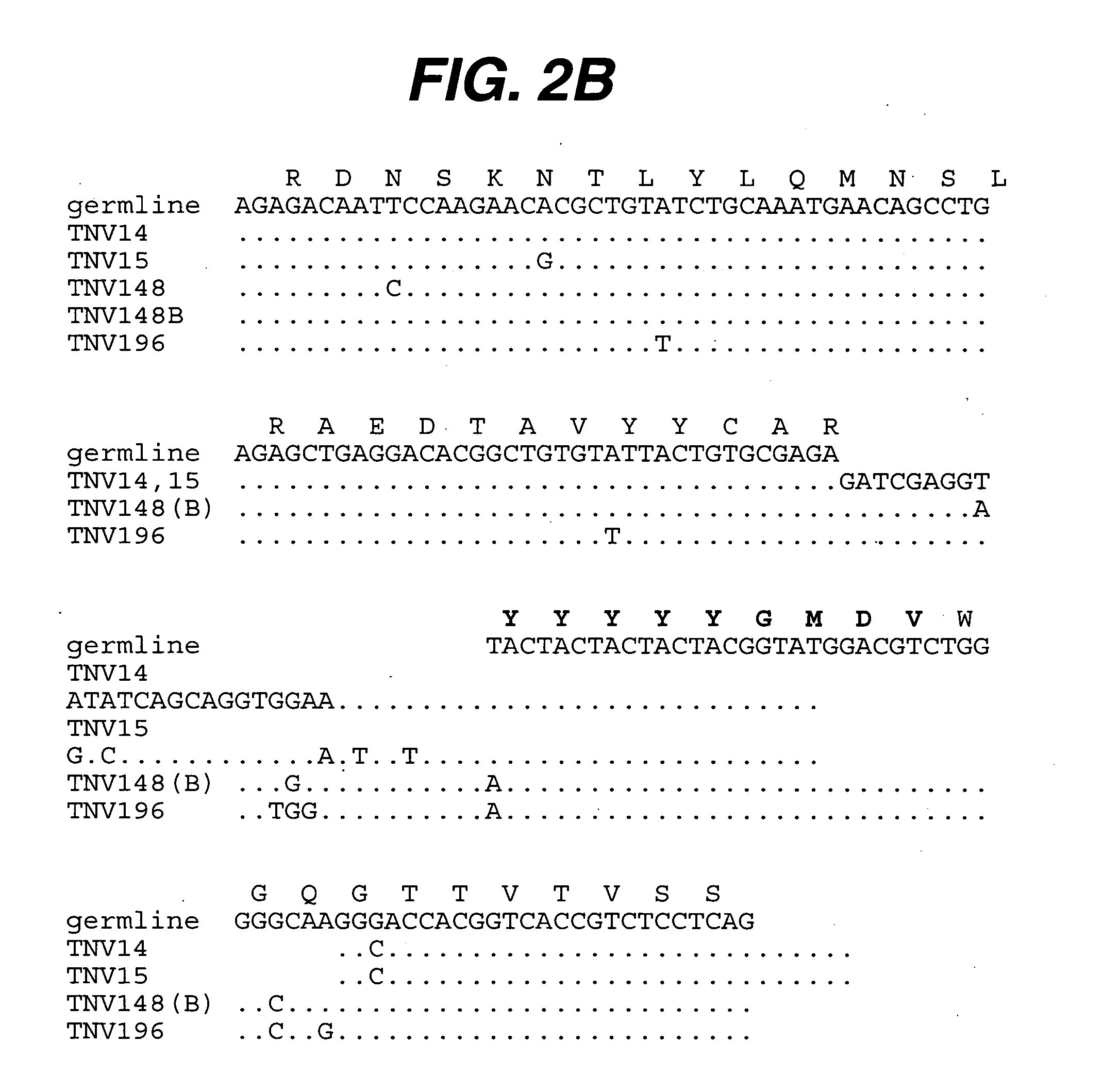Anti-TNF antibodies, compositions, methods and uses
a technology of neutralizing antibodies and compositions, applied in the field of antibodies, can solve the problems of eliciting an immune response, unable to provide a basis for producing tnf neutralizing antibodies that can be used in in vivo diagnostic or therapeutic uses in humans, and many cancer morbidity and mortality
- Summary
- Abstract
- Description
- Claims
- Application Information
AI Technical Summary
Benefits of technology
Problems solved by technology
Method used
Image
Examples
example 1
Cloning and Expression of TNF Antibody in Mammalian Cells
[0196] A typical mammalian expression vector contains at least one promoter element, which mediates the initiation of transcription of mRNA, the antibody coding sequence, and signals required for the termination of transcription and polyadenylation of the transcript. Additional elements include enhancers, Kozak sequences and intervening sequences flanked by donor and acceptor sites for RNA splicing. Highly efficient transcription can be achieved with the early and late promoters from SV40, the long terminal repeats (LTRS) from Retroviruses, e.g., RSV, HTLVI, HIVI and the early promoter of the cytomegalovirus (CMV). However, cellular elements can also be used (e.g., the human actin promoter). Suitable expression vectors for use in practicing the present invention include, for example, vectors such as pIRES1neo, pRetro-Off, pRetro-On, pLXSN, or pLNCX (Clonetech Labs, Palo Alto, Calif.), pcDNA3.1 (+ / −), pcDNA / Zeo (+ / −) or pcDNA3...
example 2
[0205] Generation of High Affinity Human IgG Monoclonal Antibodies Reactive with Human TNF Using Transgenic Mice
[0206] Summary. Transgenic mice have been used that contain human heavy and light chain immunoglobulin genes to generate high affinity, completely human, monoclonal antibodies that can be used therapeutically to inhibit the action of TNF for the treatment of one or more TNF-mediated disease. (CBA / J x C57 / BL6 / J) F2 hybrid mice containing human variable and constant region antibody transgenes for both heavy and light chains are immunized with human recombinant TNF (Taylor et al., Intl. Immunol. 6:579-591 (1993); Lonberg, et al., Nature 368:856-859 (1994); Neuberger, M., Nature Biotech. 14:826 (1996); Fishwild, et al., Nature Biotechnology 14:845-851 (1996)). Several fusions yielded one or more panels of completely human TNF reactive IgG monoclonal antibodies. The completely human anti-TNF antibodies are further characterized. All are IgG1□. Such antibodies are found to have...
example 3
Generation of Human IgG Monoclonal Antibodies Reactive to Human TNF∀
[0226] Summary. (CBA / J x C57BL / 6J) F2 hybrid mice (1-4) containing human variable and constant region antibody transgenes for both heavy and light chains were immunized with recombinant human TNF∀. One fusion, named GenTNV, yielded eight totally human IgG1κ monoclonal antibodies that bind to immobilized recombinant human TNFα. Shortly after identification, the eight cell lines were transferred to Molecular Biology for further characterization. As these Mabs are totally human in sequence, they are expected to be less immunogenic than cA2 (Remicade) in humans.
[0227] Abbreviations. BSA—bovine serum albumin; CO2—carbon dioxide; DMSO—dimethyl sulfoxide; EIA—enzyme immunoassay; FBS—fetal bovine serum; H2O2—hydrogen peroxide; HC—heavy chain, HRP—horseradish peroxidase; ID—interadermal; Ig—immunoglobulin; TNF—tissue necrosis factor alpha; IP—intraperitoneal; IV—intravenous; Mab—monoclonal antibody; OD—optical density; OPD—...
PUM
| Property | Measurement | Unit |
|---|---|---|
| concentration | aaaaa | aaaaa |
| concentration | aaaaa | aaaaa |
| molecular weight | aaaaa | aaaaa |
Abstract
Description
Claims
Application Information
 Login to View More
Login to View More - R&D
- Intellectual Property
- Life Sciences
- Materials
- Tech Scout
- Unparalleled Data Quality
- Higher Quality Content
- 60% Fewer Hallucinations
Browse by: Latest US Patents, China's latest patents, Technical Efficacy Thesaurus, Application Domain, Technology Topic, Popular Technical Reports.
© 2025 PatSnap. All rights reserved.Legal|Privacy policy|Modern Slavery Act Transparency Statement|Sitemap|About US| Contact US: help@patsnap.com



